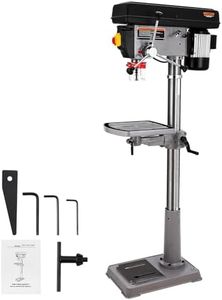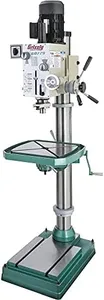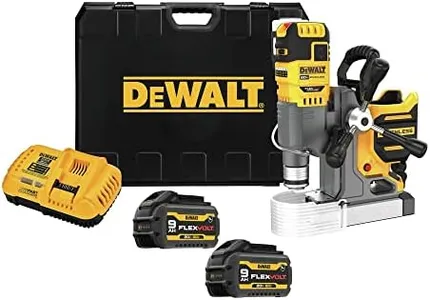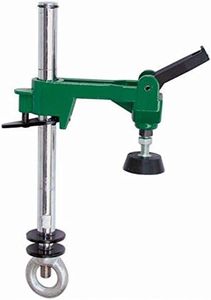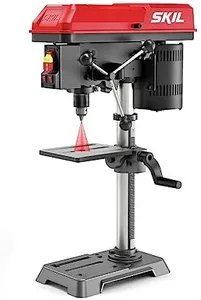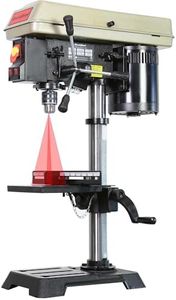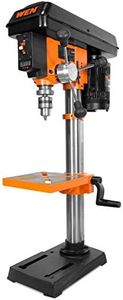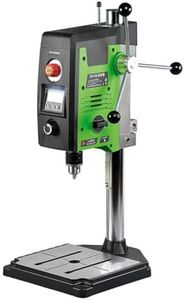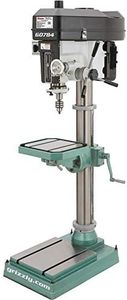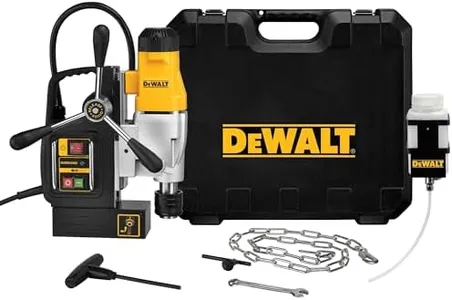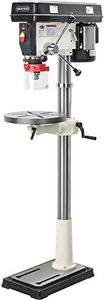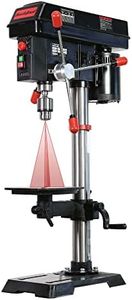10 Best Drill Presses 2025 in the United States
Our technology thoroughly searches through the online shopping world, reviewing hundreds of sites. We then process and analyze this information, updating in real-time to bring you the latest top-rated products. This way, you always get the best and most current options available.

Our Top Picks
Winner
Grizzly Industrial G0779-23-3/8" Heavy-Duty Floor Model Gearhead Drill Press
The Grizzly G0779 is a heavy-duty floor model drill press built with solid cast iron, making it very sturdy and stable during use. It features a powerful 2 horsepower motor running on 220 volts and offers 6 speed settings with a maximum speed of about 1,970 RPM, which is versatile enough for drilling various materials. The geared head with quick-change gearbox controls allows easy speed adjustments, helping you match the right speed to the job. The drill chuck accepts bits from 1/64" up to 1/2", supporting a decent range of hole sizes, and it can drill metal up to 1.25 inches thick, suitable for many workshop tasks.
The table is adjustable and can rotate 360 degrees around the column, with lock levers ensuring stability when set. The base includes precision-ground surfaces with T-slots to help secure your workpieces firmly. This model is quite heavy at 790 pounds, so it’s best suited for a fixed workshop setup rather than portable use. It requires a 220-volt power source, which may not be available in all home garages without modifications.
For those seeking a durable, precise drill press for serious metalworking or woodworking projects in a permanent space, the Grizzly G0779 provides solid performance and flexibility. However, if you need something lighter or for lighter-duty tasks, this machine might be more than necessary.
20V MAX FVA 2 IN MAGNETIC DRILL KIT
Most important from
4 reviews
The Dewalt DCD1623GX2 20V MAX Brushless Lithium-Ion Cordless Magnetic Drill Press Kit stands out in the drill-press category for its impressive versatility and power. One key strength is its high drilling capacity, allowing users to create up to a 2-inch hole through 2 inches of structural steel, which is ideal for heavy-duty applications. The drill features a unique permanent magnet that firmly attaches to steel surfaces without needing electrical power, enhancing convenience on job sites.
Another highlight is the adjustable speed feature with 10 total settings, enabling users to tailor the speed to fit the specific demands of their task. This adaptability makes it suitable for various materials and drilling requirements. The quick-change chuck system is also a valuable addition, allowing for effortless swapping between drill bits without needing extra tools, saving time and effort.
The 9 Ah battery requirement may not appeal to all users, especially those who prefer lighter or less bulky tools. The weight and size might be cumbersome for extended use or for those working in tight spaces. Additionally, being a cordless model means it requires charging, which could be a limitation for continuous operation without backup batteries. This drill press is an excellent choice for professionals and serious DIY enthusiasts who need robust performance and flexibility for metalworking and other demanding projects. Casual users or those working on lighter materials may find it more than they need, both in terms of power and potential weight. If you’re looking for a reliable and powerful drill press that can handle tough tasks, the Dewalt DCD1623GX2 is a strong contender.
Most important from
4 reviews
WEN 12-Inch Benchtop Drill Press, Variable Speed, Cast Iron with Laser and Work Light (4214T)
Most important from
3685 reviews
The WEN 12-Inch Benchtop Drill Press (4214T) is a versatile tool suitable for both hobbyists and professionals. It features a 5-amp induction motor, providing robust performance for various drilling tasks. One of its standout features is the variable speed range, adjustable from 580 to 3200 RPM, which allows for precision in different materials. The digital speed readout further enhances accuracy by displaying the current RPM. This drill press has a 12-inch swing and offers a 3-1/8-inch spindle travel, accommodating larger workpieces effectively.
Its cast iron construction ensures durability and stability during operation. The work table, measuring 9-1/2 by 9-1/2 inches, can be beveled and comes with a table roller extension, adding to its flexibility. Additionally, the built-in Class IIIA laser and overhead light provide better visibility and precision. The 5/8-inch keyed chuck and onboard storage for the chuck key add convenience.
At 85 pounds, it is relatively heavy, which might be a consideration for those with limited space or who need a more portable option. Despite this, its weight contributes to its stability. The product includes a two-year warranty, providing some peace of mind regarding its longevity. It is a reliable choice for a range of drilling needs.
Most important from
3685 reviews
Buying Guide for the Best Drill Presses
When choosing a drill press, it's important to consider your specific needs and the types of projects you'll be working on. A drill press is a versatile tool that can handle a variety of tasks, from drilling precise holes to sanding and mortising. Understanding the key specifications will help you select the best drill press for your requirements. Here are the main specs to consider and how to navigate them.FAQ
Most Popular Categories Right Now
